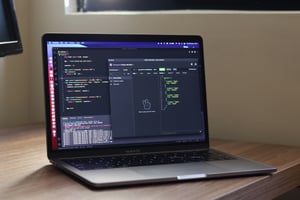Web applications are complex. As a result, performance issues can stem from many different sources....
Opentelemetry Front End (Implementing Opentelemetry In Frontend Applications)
Picture this: a user lands on your website, ready to explore. But an unexpected glitch stops them in their tracks. We've all been there, and it's frustrating. This is where front end monitoring Tools come into play, helping you catch these issues before they spoil the experience. OpenTelemetry is a key player in this space, offering powerful solutions for frontend applications. In this article, we’ll walk you through how to use it to its full potential, ensuring your app runs smoothly from end to end.
That's where Alerty comes in. This front end monitoring tool goes beyond the basics, offering insights to keep your application running smoothly and your users happy.
Table of Contents
- What Is Opentelemetry?
- 3 Key Benefits Of Using Opentelemetry In The Front End
- Understanding Opentelemetry Components
- Opentelemetry Front End: Impementing Opentelementry In The Front End
- 3 Common Challenges Of Opentelemetry
- What Is The Difference Between OpenTelemetry And Prometheus?
- 5 Best Practices Of Using Opentelemetry For The Front End
- Catch Issues Before They Affect Your Users with Alerty's Free APM Solution
What Is Opentelemetry?

OpenTelemetry, often referred to as OTel, is a powerful open-source observability framework. It provides a suite of software development kits (SDKs), vendor-neutral APIs, and tools for instrumentation. What does it do, exactly? It generates, collects, exports, and instruments telemetry data, creating a clear view of your platform’s:
- Behavior
- Performance
Developers and site reliability engineers (SREs) lean on OpenTelemetry to achieve business objectives by standardizing the process of collecting telemetry data and gaining deeper insights into how their systems are performing.
Why OpenTelemetry Matters in Cloud-Native Apps
In the world of cloud-native apps, making a system observable is a necessity. Instrumentation is the key to understanding what's happening inside your application. But here’s the rub: Instrumentation code used to be all over the place, and companies found it a pain to switch backends.
OpenTelemetry Standardization
It meant reinstrumenting code and reconfiguring agents to send telemetry data to new tools. This was not sustainable. The Cloud Native Computing Foundation (CNCF), recognizing this dilemma, sponsored the OpenTelemetry project. The objective was to create a standardized way to:
- Send
- Collect
- Transfer telemetry data to backend observability platforms
In its current form, OpenTelemetry is a merger of OpenCensus and OpenTracing, two older distributed tracing technologies. This fusion makes it a single, straightforward tool that everyone can use.
3 Key Benefits Of Using Opentelemetry In The Front End

1. Achieving Full-Stack Observability
OpenTelemetry bridges the gap between the front end and back end, offering a unified view of your app's performance. By collecting traces, metrics, and logs across the stack, you gain a comprehensive understanding of how your application behaves.
This makes pinpointing bottlenecks, performance hiccups, or elusive bugs easier. You’ll be able to see the whole picture and make data-driven decisions to enhance:
- Performance
- Stability
2. Focusing on Real User Performance
It's all about the user, right? OpenTelemetry gives you insights into your front end's real-world performance. You’ll see how long pages take to load and when users actually start interacting with your application.
These metrics are gold for fine-tuning frontend performance. You can tweak and optimize based on actual user experiences, ensuring a smooth and snappy journey for everyone who visits your app.
3. Simplifying Cross-System Correlation
Debugging can be a nightmare when your frontend and backend are out of sync. OpenTelemetry’s unified traces make it easier to track user requests across different services and components. You’ll be able to:
- Follow the trail
- See where things go wrong
- Fix them quickly
This seamless correlation simplifies debugging and performance optimization, so you can spend less time hunting down issues and more time building great features.
Ready To Step Up Your Monitoring Game?
Alerty offers a cloud monitoring service tailored for developers and early-stage startups. With technologies like NextJS, React, Vue, and Node.js supported, and databases such as:
- Supabase
- PostgreSQL
- RDS is monitored, so you’ll have everything you need to catch issues before they affect your users.
With Alerty’s free APM solution, you can get started without any cost.
Related Reading
- Application Monitoring Best Practices
- Monitor Web Application
- Browser Monitoring
- End User Performance Monitoring
- Frontend Monitoring
- Front End Optimization
- E-Commerce Monitoring
- Javascript Error Monitoring
Understanding Opentelemetry Components

In OpenTelemetry, traces are your best friend. They're like a map that shows a request's journey through your application. Imagine a user clicking a button. A trace will capture everything from the button click to the rendering of a new component and even the API calls in between.
In a React app, this means you can see how long it takes for a component to render or how quickly an API call returns. Traces are essential for understanding the flow and performance of your application.
Metrics: The Numbers That Matter
Metrics are all about numbers. They give you quantitative data about your application's performance. In React, this might include:
- Render times
- Component mount and unmount durations
- Custom business metrics
Metrics are crucial for:
- Identifying performance bottlenecks
- Tracking the impact of changes to your application
Logs: The Written Record of Your App
Logs are the textual records of events in your application. While React doesn't have built-in logging, you can integrate custom logs with OpenTelemetry.
Logs are useful for debugging and understanding the context of errors or performance issues. They provide valuable insights into your application's events at a specific time.
OpenTelemetry SDK: The Toolkit for Instrumentation
The OpenTelemetry SDK is the library that will instrument your React application. It provides:
- APIs for creating spans
- Recording metrics
- Managing context
The SDK is essential for:
- Integrating OpenTelemetry into your application
- Capturing the telemetry data you need
OpenTelemetry Collector: The Data Hub
The OpenTelemetry Collector is an optional component that receives, processes, and exports telemetry data. It's beneficial for handling data from both:
- Front end
- Back end services
The Collector allows you to centralize your telemetry data and export it to your chosen backend system for:
- Analysis
- Visualization
Exporters: The Bridge to Your Backend
Exporters are responsible for sending your telemetry data to your chosen backend system for analysis and visualization.
They act as a bridge between your application and monitoring tools, ensuring that your telemetry data is available where needed.
Opentelemetry Front End: Implementing Opentelementry In The Front End

First, you need to get the right tools into your project. OpenTelemetry offers a range of packages to suit different needs:
- Tracing
- Metrics
Framework-Specific Setup
Keep your framework in mind while installing plugins. If you’re working with React, Fetch API, or managing routes in an SPA, you’ll want specific packages.
Here’s how you do it:bashnpm install @opentelemetry/api @opentelemetry/sdk-trace-webnpm install @opentelemetry/instrumentation-fetch @opentelemetry/instrumentation-xml-http-request
Always check the OpenTelemetry GitHub repo for the latest packages tailored to your framework, whether Angular, Vue.js, or something else.
Fire It Up: Initialize the SDK
Once everything’s installed, it’s time to set things up. You’ll need to initialize the OpenTelemetry SDK so it can start managing your trace data. This process usually involves setting up the `TracerProvider` and registering any needed instrumentation.
Here’s a simple setup:javascriptimport { WebTracerProvider } from '@opentelemetry/sdk-trace-web';import { ConsoleSpanExporter, SimpleSpanProcessor } from '@opentelemetry/sdk-trace-base';import { FetchInstrumentation } from '@opentelemetry/instrumentation-fetch';import { registerInstrumentations } from '@opentelemetry/instrumentation';const provider = new WebTracerProvider();provider.addSpanProcessor(new SimpleSpanProcessor(new ConsoleSpanExporter()));provider.register();registerInstrumentations({ instrumentations: [new FetchInstrumentation()],});
This setup captures traces from the browser and traces network requests made with the Fetch API. Feel free to add more instrumentation as needed.
Sending It Out: Configure Exporters
Now that your tracer provider is running, you must send your telemetry data to a backend for analysis. OpenTelemetry supports various exporters, from open-source tools like Jaeger and Prometheus to platforms like:
- Datadog
- New Relic
Here’s how you can set up a basic HTTP exporter:bashnpm install @opentelemetry/exporter-collectorjavascriptimport { CollectorTraceExporter } from '@opentelemetry/exporter-collector';const exporter = new CollectorTraceExporter({ url: 'http://localhost:55681/v1/traces',});provider.addSpanProcessor(new SimpleSpanProcessor(exporter));
Make sure to replace `'http://localhost:55681/v1/traces'` with your backend collector’s actual URL.
Customize It: Add Custom Instrumentation
While OpenTelemetry’s automatic instrumentation covers a lot, you might want to capture specific events, like button clicks or page navigations.
Here’s how you create a trace for a custom event:javascriptconst tracer = provider.getTracer('custom-instrumentation');function handleButtonClick() { const span = tracer.startSpan('button-click'); fetch('/api/data') .then((response) => response.json()) .then((data) => { span.end(); }) .catch((error) => { span.recordException(error); span.end(); });}document.getElementById('myButton').addEventListener('click', handleButtonClick);
Trace Visualization
Clicking the button starts a trace, capturing the duration of an API request. You can add details to the span, like user IDs or performance metrics, to get a clearer picture of what’s happening.
3 Common Challenges Of Opentelemetry

1. OpenTelemetry's Limits: Unsupported Data Types
OpenTelemetry is a powerful tool, but there are better solutions. Right now, it focuses on three primary data types:
- Traces
- Metrics
- Logs
That’s great if those are all you need, but what if your application requires something different? You might find yourself hunting for other tools to fill in the gaps. This isn't ideal when you want a unified observability solution.
2. The Complexity of OpenTelemetry: A Steep Learning Curve
Setting up OpenTelemetry isn’t exactly a walk in the park. It requires a certain level of expertise in observability. Developers might find themselves tangled in a web of configurations for components like:
- The collector
- Exporters
- Instrumentation
Plus, it’s a project in rapid development. Keeping up with updates and changes can feel like running on a treadmill, when you think you’re caught up, another update drops.
3. Maintenance Woes: The Challenges of Scaling OpenTelemetry
As your deployment grows, so do the headaches. Managing OpenTelemetry at scale demands constant attention to its:
- Health
- Troubleshooting glitches
- Tweaking configurations
This can be a heavy lift for smaller teams and a significant burden even for larger ones. It's not just set-and-forget; it’s more like:
- Set
- Monitor
- Adjust
- Repeat
Related Reading
- Front End Performance Testing
- End User Application Monitoring
- Frontend Performance
- Opentelemetry Browser
- Measure Page Load Time
- Javascript Performance Monitoring
- Front End Observability
- Front End Metrics
- Datadog Pricing
- Sentry Pricing
What Is The Difference Between OpenTelemetry And Prometheus?

Prometheus, born in 2012 and nurtured by SoundCloud, is your go-to for monitoring time-series data. It’s rocking the open-source scene as part of the CNCF. Prometheus does the legwork of:
- Collecting
- Processing
- Querying metrics with style
Metrics Endpoint Setup
It offers client libraries and framework integrations that simplify exposing a metrics endpoint. This endpoint acts like a beacon for Prometheus to scrape data using its own formats, such as textual and protobuf.
It breaks down metrics into types like:
- Counters, which stay on the rise
- Histograms, which offer insights into percentiles and averages
OpenTelemetry: A Different Approach
Now, let’s pivot to OpenTelemetry, which has its vibe with “instruments” instead of metrics. These instruments can map onto Prometheus if you’re using the right exporter. OpenTelemetry branches out with exporters for formats like:
- OpenCensus
- InfluxDB
- Elastic
You’re not boxed in. It’s a flexible and agile system ready to be adapted to your needs by mixing various formats.
Swapping Formats and Sharing Data
Regarding processing and storage, Prometheus and its friends have options. They get along with projects that scrape and receive metrics in Prometheus’ format. Whether it’s Prometheus itself or pals like:
- Thanos
- Cortex
- Timescale, they’ve got shared goals.
It’s all about getting the data where it needs to go in a language everyone understands. These projects ensure seamless integration and smooth data flow across systems.
5 Best Practices Of Using Opentelemetry For The Front End

1. Kickstart Auto-Instrumentation for Quick Wins
Auto-instrumentation is a game-changer when setting up OpenTelemetry for the front end. This feature captures telemetry data from common web APIs and frameworks without requiring you to write much code. Start by enabling auto-instrumentation to establish quickly:
- Basic tracing
- Metrics collection
Once the basics are in place, you can fine-tune with manual instrumentation in areas where you need more detailed insights.
2. Initialize OpenTelemetry Right from the Start
Getting OpenTelemetry up and running early is crucial. Make sure you set up your tracer and configurations at the very start of your application.
This setup should happen before any libraries that need instrumentation are loaded. Proper initialization ensures you capture all spans and traces accurately from the get-go.
3. Define Attributes That Matter
When you create spans, include meaningful attributes that provide context. When tracing an HTTP request, include attributes like:
- The request method
- URL
- Response status
Consistent and relevant attributes help you filter and analyze telemetry data effectively. Avoid adding redundant attributes to keep your data:
- Clean
- Manageable
4. Ensure Data Correlation Across Services
To get a complete picture of your application’s performance, correlate telemetry data across both:
- Front end
- Backend services
Use trace IDs to link frontend actions, like user interactions, to backend processes. This correlation allows you to trace a request's entire journey, making it easier to pinpoint:
- Performance bottlenecks
- Errors
5. Regularly Review and Refine Your Instrumentation
As your application evolves, make it a habit to review your OpenTelemetry instrumentation. This involves checking:
- That your spans are capturing relevant data
- That your attributes remain meaningful
Optimize your instrumentation based on performance metrics and user feedback to continuously improve the observability of your application.
Related Reading
- Dynatrace Pricing
- Web Applications Monitoring Tools
- API Monitoring
- End User Monitoring
- End User Experience Monitoring Tools
- Manageengine Alternatives
- Logrocket Alternatives
- Pingdom Alternatives
- Opentelemetry Alternatives
- Bugsnag Alternatives
- Javascript Monitoring Tools
- Rollbar Alternatives
Catch Issues Before They Affect Your Users with Alerty's Free APM Solution
Alerty offers a robust monitoring solution designed for developers and early-stage startups. It provides:
- Application performance monitoring (APM)
- Database monitoring
- Incident management
With support for technologies like:
- NextJS
- React
- Vue
- Node.js
Database and API Monitoring
Alerty helps developers identify and fix issues quickly. It monitors databases like:
- Supabase
- PostgreSQL
- RDS, tracking key metrics such as CPU usage and memory consumption
It also features quick incident management and Real User Monitoring (RUM) to optimize user experience. Its Universal Service Monitoring covers dependencies like:
- Stripe API
- OpenAI
- Vercel
AI-Powered Efficiency
Alerty uses AI to simplify setup, providing a cost-effective solution compared to competitors. Designed for ease of use, it allows quick setup and integrates with tools like Sentry, making it ideal for developers and small teams needing efficient, affordable monitoring.







